Jason Tesar's Blog, page 6
January 31, 2014
My Creative Process...the first part, at least
It’s been quiet here on my blog lately; I’m down in the trenches with writing Book Six of The Awakened and haven’t had time to do much of anything but write, write, write. From what readers tell me, that’s exactly how I should be spending my time. But I wrote this post earlier in the month and thought I’d finally put it up, just so you know I haven’t fallen off the face of the earth.
Since I’m knee-deep in the creative process, and many people have asked me what it takes to turn an idea into a story, I’d like to share the first part of my writing process with you.
As I mentioned in an earlier post, I prefer to work from general things to specific details, from higher-level thinking to lower-level thinking. Some authors just sit down and start typing, relying on the spontaneity of the moment to direct their stories. I like to start with a framework, and make room for spontaneity at the lower levels of detail. Rather than writing and scrapping whole chapters, as some do, my process is to go through those motions mentally.
The first stage of my creative process is to approach the story as a sculpture. I begin chipping away at it from multiple angles until the final form is revealed. I live on both sides of the plot-versus-character debate. If there are particular plot details that are non-negotiable—events that must take place—I write them down. If there are certain character developments that are a necessity, I write those down as well. Then I begin to ask myself questions.
“What characters are involved in this story? What do they want? What is standing in their way? Should they achieve their goals, or be prevented from them? What emotional issues are they struggling with? How will they overcome these issues? Where do I want this character to end up in contrast to where they started?”
When I’ve run out of creative energy on the character front, I switch to the plot.
“Are there political alliances involved? If so, how would they react to this event? How can I add more tension to that scene? How can I make that thing that must occur into something interesting for the reader? How can use this character’s subplot to complicate or reinforce the main plot? How does this setup the story for the next book?”
Round and round I go, until the story begins to take shape. When I have a good grasp of the individual elements of the story, then I start looking for how to piece them together into a coherent story. I call this process storyboarding, based on the visual puzzle assembly process used in the movie industry. And this brings up another slew of questions.
“Are there too many scenes from this character’s perspective? Do I have too many non-action scenes bunched together? Is there any emotional development taking place during this battle scene? What can I do to speed up the pace of this section? What does the reader need to see here in order to catch their breath?”
When all the puzzle pieces are in place, the story has its framework. I can rest assured that a critical detail hasn’t been left out. I know where the story is going and how it will get there.
Now it’s time to start typing, which requires a whole different level of creativity.
Since I’m knee-deep in the creative process, and many people have asked me what it takes to turn an idea into a story, I’d like to share the first part of my writing process with you.
As I mentioned in an earlier post, I prefer to work from general things to specific details, from higher-level thinking to lower-level thinking. Some authors just sit down and start typing, relying on the spontaneity of the moment to direct their stories. I like to start with a framework, and make room for spontaneity at the lower levels of detail. Rather than writing and scrapping whole chapters, as some do, my process is to go through those motions mentally.
The first stage of my creative process is to approach the story as a sculpture. I begin chipping away at it from multiple angles until the final form is revealed. I live on both sides of the plot-versus-character debate. If there are particular plot details that are non-negotiable—events that must take place—I write them down. If there are certain character developments that are a necessity, I write those down as well. Then I begin to ask myself questions.
“What characters are involved in this story? What do they want? What is standing in their way? Should they achieve their goals, or be prevented from them? What emotional issues are they struggling with? How will they overcome these issues? Where do I want this character to end up in contrast to where they started?”
When I’ve run out of creative energy on the character front, I switch to the plot.
“Are there political alliances involved? If so, how would they react to this event? How can I add more tension to that scene? How can I make that thing that must occur into something interesting for the reader? How can use this character’s subplot to complicate or reinforce the main plot? How does this setup the story for the next book?”
Round and round I go, until the story begins to take shape. When I have a good grasp of the individual elements of the story, then I start looking for how to piece them together into a coherent story. I call this process storyboarding, based on the visual puzzle assembly process used in the movie industry. And this brings up another slew of questions.
“Are there too many scenes from this character’s perspective? Do I have too many non-action scenes bunched together? Is there any emotional development taking place during this battle scene? What can I do to speed up the pace of this section? What does the reader need to see here in order to catch their breath?”
When all the puzzle pieces are in place, the story has its framework. I can rest assured that a critical detail hasn’t been left out. I know where the story is going and how it will get there.
Now it’s time to start typing, which requires a whole different level of creativity.
Published on January 31, 2014 06:48
December 17, 2013
Behind-the-Scenes: The City of Bastul
In the first edition of my email newsletter (October 1st, 2013, which you can read here), I included some behind-the-scenes info about the city of Bastul that fans hadn't been able to read anywhere else. With my next newsletter scheduled to go out on January 1st, 2014, I thought I would share that portion of October's content here on my blog. If you would like access to this type of information as soon as it is available, please sign up for my email newsletter here.
The City of Bastul
Aside from the scenes that occur in our own world, the Awakened story begins in and around the city of Bastul, which is a fitting place to kick-off this segment. Bastul is the southernmost city in the Orudan Empire, located on the tip of a finger of land—not quite a peninsula. Because of its location, citizens can see both the sunrise and sunset over the ocean. It is a port city, inspired by the Greek Isles, with white stone buildings of Greek/Roman architecture in the wealthier districts and wooden structures in the poorer districts. The surrounding terrain is characterized by rolling foothills with taller mountains farther inland (in the distance). The trees are clustered into forests with sparse areas between (neither heavily forested, nor bare). The coastline is a mixture of white sandy beaches (with dunes and clumps of long, pale grasses) and rocky outcroppings (with shrubbery). Warm weather, sunrises, and sunsets are what I imagined when thinking about this city.
Most of the fantasy stories I read growing up took place in misty, England-inspired settings and usually involved dragons and knights. When I began writing in the winter of 1998, I knew I wanted an entirely different backdrop for my series. I was inspired by research into the late Greek/early Roman civilizations and a drier, dustier landscape seemed to provide the gritty realism that I wanted. Little did I know that several movies (such as Gladiator, Troy, 300, Clash of the Titans, etc.) would soon popularize this time period and setting. Bastul was the city that encapsulated this backdrop, set the tone for the rest of my story, and represented my attempt at bucking the trends of the fantasy genre.
For your viewing pleasure, here is a rough sketch that helped me orient my imagination while writing those first scenes:
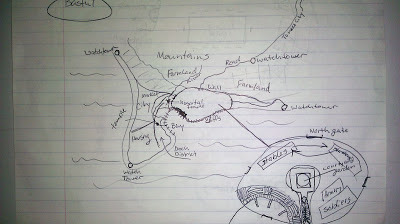
The City of Bastul
Aside from the scenes that occur in our own world, the Awakened story begins in and around the city of Bastul, which is a fitting place to kick-off this segment. Bastul is the southernmost city in the Orudan Empire, located on the tip of a finger of land—not quite a peninsula. Because of its location, citizens can see both the sunrise and sunset over the ocean. It is a port city, inspired by the Greek Isles, with white stone buildings of Greek/Roman architecture in the wealthier districts and wooden structures in the poorer districts. The surrounding terrain is characterized by rolling foothills with taller mountains farther inland (in the distance). The trees are clustered into forests with sparse areas between (neither heavily forested, nor bare). The coastline is a mixture of white sandy beaches (with dunes and clumps of long, pale grasses) and rocky outcroppings (with shrubbery). Warm weather, sunrises, and sunsets are what I imagined when thinking about this city.
Most of the fantasy stories I read growing up took place in misty, England-inspired settings and usually involved dragons and knights. When I began writing in the winter of 1998, I knew I wanted an entirely different backdrop for my series. I was inspired by research into the late Greek/early Roman civilizations and a drier, dustier landscape seemed to provide the gritty realism that I wanted. Little did I know that several movies (such as Gladiator, Troy, 300, Clash of the Titans, etc.) would soon popularize this time period and setting. Bastul was the city that encapsulated this backdrop, set the tone for the rest of my story, and represented my attempt at bucking the trends of the fantasy genre.
For your viewing pleasure, here is a rough sketch that helped me orient my imagination while writing those first scenes:

Published on December 17, 2013 10:06
December 11, 2013
Hidden from Men is now available for Apple devices and others
Hidden from Men is now available for your Apple devices through iTunes. And those of you who buy ebooks through Kobo, Sony, or Diesel can also pick up a copy.
Click here to view it on iTunes
Click here to view it on Kobo
Click here to view it on Sony
Click here to view it on Diesel
Click here to view it on iTunes
Click here to view it on Kobo
Click here to view it on Sony
Click here to view it on Diesel
Published on December 11, 2013 07:37
December 2, 2013
Hidden From Men: The Awakened Book Five is now available in a variety of formats
The release of Hidden From Men: The Awakened Book Five continues with several new formats. In addition to last month's release of the novel for the Kindle, it is now available for the Nook. And if you don't have an eReading device, it is also available in paperback through Amazon, Barnes & Noble, and CreateSpace. Additional ebook formats are in progress (Apple, Sony, Kobo, and Diesel) and I will announce them as they become available.
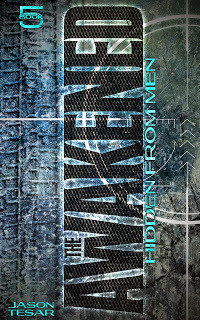

Published on December 02, 2013 12:57
November 21, 2013
Hidden From Men: The Awakened Book Five is now available
Hidden From Men: The Awakened Book Five is now available for your Kindle or Nook. More formats will be available soon.
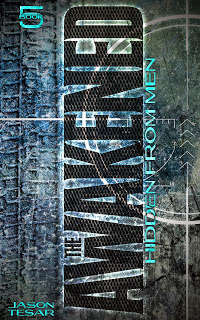

Published on November 21, 2013 09:03
November 16, 2013
Release date for Hidden From Men: The Awakened Book Five
As an indie publisher, I'm not able to control the precise release date for Hidden From Men: The Awakened Book Five through Amazon. However, I plan to upload the files next week (taking into account their time to process the information) so that all the ebook versions from various distributors (Kindle, Nook, iPad, etc.) are available on Thursday (11/21/13).
Published on November 16, 2013 11:43
November 13, 2013
Back-of-the-book description for Hidden From Men: The Awakened Book Five
As the countdown continues for the release of Hidden From Men: The Awakened Book Five, here's another tidbit for you...the back-of-the-book description:
A powerful adversary is surfacing and Null’s covert battle is on the threshold of open war.
Reunited with his father after twenty-two years, Kael must find the balance between protecting him and confronting the enemy who stands between them and their home world. The timelessness of the In-Between has stolen the years that separated Kael and Adair by age, leaving them as distant equals. Having glimpsed Kael’s destiny from the Eternal Realm, Adair struggles to find his role in the life of a son who no longer needs him. Through a global maze of counterintelligence and espionage, a multinational team of operatives has to survive long enough to turn the tide of war. And a father and son will discover how to rebuild what was taken from their lives.
In book five of the bestselling Awakened series, Jason Tesar’s epic saga escapes the islands of Scandinavia for the dark forests and rugged mountains of Russia in a tense conflict of subterfuge that blurs the boundaries between sci-fantasy and military fiction.
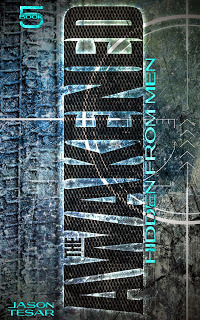
A powerful adversary is surfacing and Null’s covert battle is on the threshold of open war.
Reunited with his father after twenty-two years, Kael must find the balance between protecting him and confronting the enemy who stands between them and their home world. The timelessness of the In-Between has stolen the years that separated Kael and Adair by age, leaving them as distant equals. Having glimpsed Kael’s destiny from the Eternal Realm, Adair struggles to find his role in the life of a son who no longer needs him. Through a global maze of counterintelligence and espionage, a multinational team of operatives has to survive long enough to turn the tide of war. And a father and son will discover how to rebuild what was taken from their lives.
In book five of the bestselling Awakened series, Jason Tesar’s epic saga escapes the islands of Scandinavia for the dark forests and rugged mountains of Russia in a tense conflict of subterfuge that blurs the boundaries between sci-fantasy and military fiction.

Published on November 13, 2013 15:09
November 12, 2013
Cover Artwork for Hidden From Men: The Awakened Book Five
The release of "Hidden From Men: The Awakened Book Five" is just around the corner. To whet your appetite, here's a sneak peak at the cover artwork.
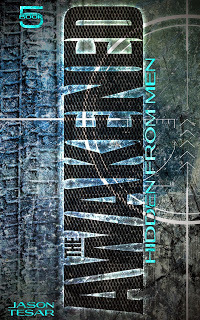

Published on November 12, 2013 12:30
August 29, 2013
My Cliffhanger Endings
Over the past few years, numerous readers have written Amazon reviews and commented on Facebook and my blog about their love/hate relationship with my cliffhanger endings. So, I wanted to take this opportunity to explain my philosophy.
First of all, I love good endings. A comprehensive, satisfying resolution to a story can make the whole experience of reading a book or watching a movie seem worthwhile. One of my favorites is the movie version of The Shawshank Redemption—corruption is exposed, the bad guys get what’s coming to them, and the wrongly accused, unjustly convicted hero of the story finally escapes. The last scene shows him on a beach in Mexico as the camera pulls back to reveal the endless Pacific—a colorful and optimistic contrast to the drab, hopeless prison where he spent the majority of his life. By the time the credits roll, Andy Dufresne’s story has been told and we don’t need to know anything more about him than the assurance that he will live his remaining years in a warm, tropical, leisure environment. He has certainly earned it!
For a stand-alone, self-contained story like this, I want everything to be resolved. When I say resolution, I don’t mean that everything comes to an end. In any story, there will always be the question of “what happens next?” which could go on and on until the character dies. And even then, one could ask how the death will affect friends and family of the character. These questions are meaningless because they don’t impact the story that has just been told. “Does Andy complete the restoration of the boat? Does he start a sport fishing business for tourists? Does he get back into the banking industry in Mexico?”
Who cares? The story is over. In my mind, it is resolved.
But what about stories that aren’t stand-alone units? Consider the extended format of a TV series. Another favorite of mine was 24, with Jack Bauer running around Los Angeles, hunting for terrorists. Each episode contained an immediate challenge or subplot that was presented and resolved, all the while advancing the larger plot toward the season finale. At an even higher level, each season was part of a larger arc in terms of the nation’s politics and the lives of the main characters.
For each novel or episode within a series, I want some amount of resolution—if possible, resolution of the primary issue that forms the backbone of the story. If not the primary issue, then I want to see the story come to rest at a natural stopping point, perhaps before a large span of time where nothing significant occurs, or the point between two distinct periods of time in a character’s life. I want to see the major and minor plots moved forward, deepened, or complicated in some way. And I want an ending that gets me excited about the next book.
I’ll admit—from novel to novel—the first two Awakened books (Awaken His Eyes and Paths of Destruction) don’t have neat, tidy endings. Along with the third book, they were all written as one story and at the time I wrote them, my knowledge of story construction and my philosophy of endings were both undeveloped. But there is another type of ending I was able to accomplish at the end of Hands to Make War—an intermediate point of resolution. For those who haven’t yet read the third book in the Awakened series, I won’t spoil the details. I will point out, however, that the forces of antagonism which produce the physical conflicts in Kael’s world—and define the backbone of the story—are dealt with. The primary plot in the ancient world is resolved—the first trilogy completed. At the same time, the stage is set for the next segment of the series which jumps into our modern world. This closing of one door and opening of another is a major milestone in the larger saga, resolving the immediate matters while propelling the reader forward.
So, on one hand I totally understand the irritation of a cliffhanger. Who wants to be forced to wait for the next part of the story? No one! That much I have learned already from readers who have finished the fourth book in the series, Seeds of Corruption. On the other hand, I wouldn’t want it any other way. If the story isn’t done, I don’t’ want resolution. I want an ending that makes me feel like it’s the most important thing in the world to find out what happens next. If I have to wait, sure I’ll be disappointed that the next story isn’t available. But I’ll also enjoy the in-between period of delayed gratification, when I can reflect on the story, think about the characters and plot, and try to figure out where it’s going.
For me, it deepens the imaginative experience and makes the joy of reading or watching only that much better!
If you don’t agree and are thinking, just hurry up and write the next one, I want to assure you that I’m working as fast as I can. Trust me; no one wants to see this series completed more than I do. But I don’t want to compromise the quality of the stories by writing junk. So, I’ll make this commitment:
I’ll release the next book as soon as possible, but not a moment too soon!
First of all, I love good endings. A comprehensive, satisfying resolution to a story can make the whole experience of reading a book or watching a movie seem worthwhile. One of my favorites is the movie version of The Shawshank Redemption—corruption is exposed, the bad guys get what’s coming to them, and the wrongly accused, unjustly convicted hero of the story finally escapes. The last scene shows him on a beach in Mexico as the camera pulls back to reveal the endless Pacific—a colorful and optimistic contrast to the drab, hopeless prison where he spent the majority of his life. By the time the credits roll, Andy Dufresne’s story has been told and we don’t need to know anything more about him than the assurance that he will live his remaining years in a warm, tropical, leisure environment. He has certainly earned it!
For a stand-alone, self-contained story like this, I want everything to be resolved. When I say resolution, I don’t mean that everything comes to an end. In any story, there will always be the question of “what happens next?” which could go on and on until the character dies. And even then, one could ask how the death will affect friends and family of the character. These questions are meaningless because they don’t impact the story that has just been told. “Does Andy complete the restoration of the boat? Does he start a sport fishing business for tourists? Does he get back into the banking industry in Mexico?”
Who cares? The story is over. In my mind, it is resolved.
But what about stories that aren’t stand-alone units? Consider the extended format of a TV series. Another favorite of mine was 24, with Jack Bauer running around Los Angeles, hunting for terrorists. Each episode contained an immediate challenge or subplot that was presented and resolved, all the while advancing the larger plot toward the season finale. At an even higher level, each season was part of a larger arc in terms of the nation’s politics and the lives of the main characters.
For each novel or episode within a series, I want some amount of resolution—if possible, resolution of the primary issue that forms the backbone of the story. If not the primary issue, then I want to see the story come to rest at a natural stopping point, perhaps before a large span of time where nothing significant occurs, or the point between two distinct periods of time in a character’s life. I want to see the major and minor plots moved forward, deepened, or complicated in some way. And I want an ending that gets me excited about the next book.
I’ll admit—from novel to novel—the first two Awakened books (Awaken His Eyes and Paths of Destruction) don’t have neat, tidy endings. Along with the third book, they were all written as one story and at the time I wrote them, my knowledge of story construction and my philosophy of endings were both undeveloped. But there is another type of ending I was able to accomplish at the end of Hands to Make War—an intermediate point of resolution. For those who haven’t yet read the third book in the Awakened series, I won’t spoil the details. I will point out, however, that the forces of antagonism which produce the physical conflicts in Kael’s world—and define the backbone of the story—are dealt with. The primary plot in the ancient world is resolved—the first trilogy completed. At the same time, the stage is set for the next segment of the series which jumps into our modern world. This closing of one door and opening of another is a major milestone in the larger saga, resolving the immediate matters while propelling the reader forward.
So, on one hand I totally understand the irritation of a cliffhanger. Who wants to be forced to wait for the next part of the story? No one! That much I have learned already from readers who have finished the fourth book in the series, Seeds of Corruption. On the other hand, I wouldn’t want it any other way. If the story isn’t done, I don’t’ want resolution. I want an ending that makes me feel like it’s the most important thing in the world to find out what happens next. If I have to wait, sure I’ll be disappointed that the next story isn’t available. But I’ll also enjoy the in-between period of delayed gratification, when I can reflect on the story, think about the characters and plot, and try to figure out where it’s going.
For me, it deepens the imaginative experience and makes the joy of reading or watching only that much better!
If you don’t agree and are thinking, just hurry up and write the next one, I want to assure you that I’m working as fast as I can. Trust me; no one wants to see this series completed more than I do. But I don’t want to compromise the quality of the stories by writing junk. So, I’ll make this commitment:
I’ll release the next book as soon as possible, but not a moment too soon!
Published on August 29, 2013 11:56
August 20, 2013
Subscribe to my mailing list
I've just added an email signup form to my blog. If you are interested in receiving book release announcements and other notifications by email, please enter your address in the field below—entitled Subscribe to my mailing list—and press Subscribe.
Published on August 20, 2013 08:42



